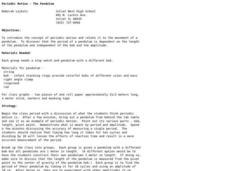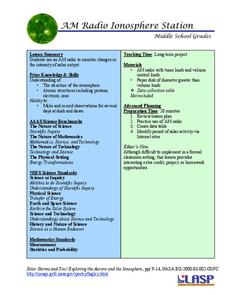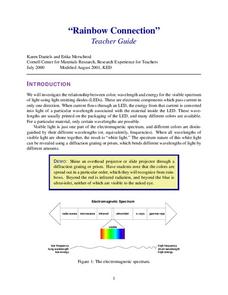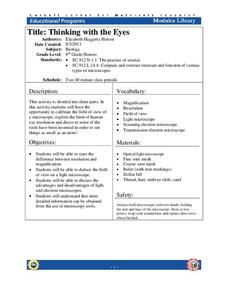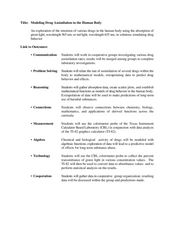Curated OER
Electromagnetic Energy and Its Spectrum
Your older elementary students investigate electromagnetic energy and the electromagnetic spectrum. They will observe 7 items represented in the electromagnetic spectrum and make a poster of all the things the items have in common. After...
Curated OER
Wavelengths of Light
Explore physical science by participating in a visual spectrum experiments. Budding scientists identify the colors in the color spectrum and view the colors in class by utilizing cellophane, flash lights, and other arts and crafts...
Santa Monica College
Flame Tests of Metal Cations
Scientists used flame tests to identify elements long before the invention of emission spectroscopy. Young chemists observe a flame test of five metal cations in the fourth instructional activity of an 11-part series. Individuals then...
Curated OER
Wavelength and Energy
Pupils using a rope and other materials explore wavelengths and frequency. If time permits, more experiments can be tried.
Curated OER
Periodic Motion - The Pendulum
Students experiment to determine the period of a pendulum. For this periodic motion lesson, students use different pendulums to determine their periods. They use various amplitudes to determine its effects on the period.
PHET
AM Radio Ionosphere Station
Tune in! Young scientists use an AM radio at home to monitor solar output. The long-term project would be ideal in a flipped classroom or as an out-of-class project.
Curated OER
Gamma Ray Bursts
Young scholars study an article on Gamma Rays. For this investigative lesson students study the energy and wavelengths of gamma rays and the theories behind them.
Cornell University
LEDs Rainbow Connection
View LED lights through the eyes of a scientist. Young scholars learn to view light as a wave frequency and connect various frequencies to different colors on the light spectrum. A lab activity asks groups to measure the frequency of...
National Wildlife Federation
Quantifying Land Changes Over Time Using Landsat
"Humans have become a geologic agent comparable to erosion and [volcanic] eruptions ..." Paul J. Crutzen, a Nobel Prize-winning atmospheric chemist. Using Landsat imagery, scholars create a grid showing land use type, such as urban,...
Curated OER
Wave Motion
Students observe and identify various waves. In this wave motion lesson, student use a Slinky, noise, people, and musical instruments to create waves and observe how each type of wave moves.
LABScI
Acoustics: The Sound Lab
If the delay between a sound and its echo is less than 1/10th of a second, the human ear can’t distinguish it. Through the use of a Slinky, rubber band guitar, and straws, scholars explore where sound comes from and how it travels....
National Nanotechnology Infrastructure Network
Understanding Wave Motion - Slinky vs. Snaky: Which Spring is Dominant?
Ride the wave to an understanding of refraction! The first in a series of two inquiry-based lessons challenges learners to create transverse waves with two different types of springs. As their wave hits an object, they observe the change...
Curated OER
Climate And the Greenhouse Effect
Students demonstrate the greenhouse effect. They recognize that relatively small changes to our environment can stimulate significant climate changes. They determine that the "scientific method" is a process of testing hypotheses and...
American Chemical Society
Isolation of Phytochrome
Why do soybean plants that are planted weeks apart in the spring mature simultaneously in the fall? Four independent activities cover the history of phytochrome research, scientist collaboration, the electromagnetic spectrum, and...
Cornell University
Thinking with the Eyes
Objects are larger (or smaller) than they appear! Scholars use a laboratory investigation to explore the difference between resolution and magnification. The activity allows them to calculate the size of the field of view of their light...
Curated OER
Making Waves with the Electromagnetic Spectrum
Students explore various types of electromagnetic waves, the range of the spectrum, and common sources of electromagnetic waves.
Curated OER
Fiber Optics
This is a printout of the slides for a presentation on fiber optics. In bullet-style notes, it covers how optic fibers work, their structure, different types, and their use. You may use these as a lecture guide, or if you want to take...
Curated OER
Keep It Quiet!
Fourth graders study about sound waves and how they behave in various media. They create a soundproofed container. They explain that velocity describes a change in distance over time.
Curated OER
The Effects of Ultraviolet Light on Lumbriculus
Students explore the effects of ultraviolet light on Lumbriculus. They expose ultraviolet light to Lumbriculus (worm) and determine the lethal exposure time. They examine the worm and record their observations.
Curated OER
Modeling Drug Assimilation in the Human Body
Students investigate the accumulation of drugs in the body. In this algebra instructional activity, students collect data on drug retention and assimilation. They use their data to predict the behavior and effects of drugs.
Curated OER
Solar Lesson
First graders complete sunlight and solar effects activities to learn about light and its power. In this solar activity lesson, 1st graders complete a sunscreen test activity, a light test, a black light test, a cloudy test, a sunglasses...
Curated OER
From Vibration to Sound
Students observe a series of demonstrations to illustrate wave movement. In this sound wave lesson, students witness how objects create waves when dropped in a dish of water, use a rope and slinky to produce transverse and longitudinal...
Curated OER
Solar Oven
Young scholars construct a solar oven using cardboard, duct tape, aluminum foil and other materials. They use the solar oven to cook something and keep a journal of their project.
Curated OER
Photosynthetically Available Radiation (PAR) Measurements
Students calculate the amount of solar radiation hitting the ground at their school compared to the solar constant. They also repeat the experiment at a water testing site and utilize a light probe to measure the light being reflected...




